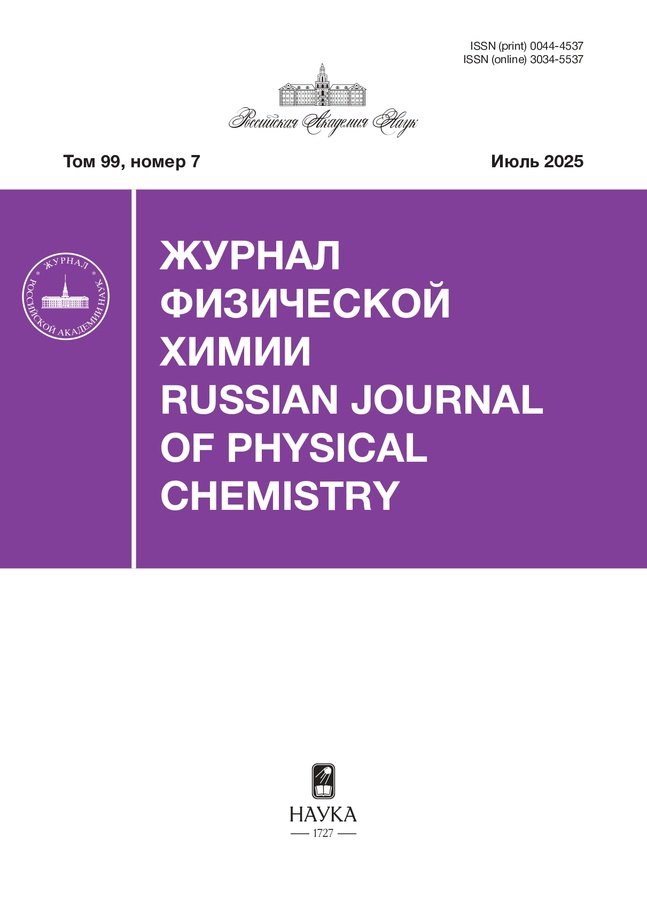Formation of polymolecular associates of short-chain peptides with copper ions under electrospray ionization conditions
- Autores: Kuznetsova E.S.1, Pytsky I.S.1, Buryak A.K.1
-
Afiliações:
- Federal State Budgetary Institution of Science A. N. Frumkin Institute of Physical Chemistry and Electrochemistry
- Edição: Volume 99, Nº 7 (2025)
- Páginas: 1113-1120
- Seção: PHYSICAL CHEMISTRY OF SEPARATION PROCESSES. CHROMATOGRAPHY
- ##submission.dateSubmitted##: 17.10.2025
- ##submission.datePublished##: 15.07.2025
- URL: https://pediatria.orscience.ru/0044-4537/article/view/693653
- DOI: https://doi.org/10.7868/S3034553725070178
- ID: 693653
Citar
Texto integral
Resumo
The ionization processes of short-chain peptides in the presence of cationizing agents – metal salts – have been studied. The electrospray ionization method with mass spectrometric detection was used in this work. The mass spectrometric study demonstrated the ability of peptides to form cluster compounds with transition metal ions such as copper. It was shown that up to 2–4 peptide molecules are associated around one charged metal center. A hypothesis on the mechanism of formation of these clusters is proposed in this work, which is confirmed by experimental data.
Palavras-chave
Sobre autores
E. Kuznetsova
Federal State Budgetary Institution of Science A. N. Frumkin Institute of Physical Chemistry and Electrochemistry
Email: eskuznetsova8@yandex.ru
Moscow, Russia
I. Pytsky
Federal State Budgetary Institution of Science A. N. Frumkin Institute of Physical Chemistry and ElectrochemistryMoscow, Russia
A. Buryak
Federal State Budgetary Institution of Science A. N. Frumkin Institute of Physical Chemistry and ElectrochemistryMoscow, Russia
Bibliografia
- Cohen L.H., Gusev A.I. // Anal. Bioanal. Chem. 2002. 373. P. 571. doi: 10.1007/s00216-002-1321-z
- Karas M., Krüger R. // Chem. Rev. 2003. 103. № 2. P. 427. doi: 10.1021/cr010376a
- Chen Y., Chen H., Aleksandrov A., Orlando T.M. // J. Phys. Chem. C. 2008. 112. № 17. P. 6953. doi: 10.1021/jp077002r
- Budimir N., Blais J.-Cl., Fournier F. Tabet J.-Cl. // Rapid Commun. Mass Spectrom. 2006. 20. P. 680. doi: 10.1002/rcm.2363
- Xinyao Ju, Shuzhen Cheng, Han Li, et al. // Food Chemistry. 2022. V. 390. doi: 10.1016/j.foodchem.2022.133146
- Iavorschi M., Lupăescu A., Darie-Ion L., et al. // Pharmaceuticals, 2022. V. 15(9). doi: 10.3390/ph15091096
- Bo-Ra Kim, Ho-Tae Kim // Bull. Korean Chem. Soc. 2007. V. 28. № 5.
- Murariu M. // Intern. J. of Mass Spectrometry. V. 351. 2013. P. 12. doi: 10.1016/j.ijms.2013.05.009
- Carlton D.D. Jr., Schug K.A. // Analytica Chimica Acta. V. 686. 2011. P. 19. doi: 10.1016/j.aca.2010.11.050
- Pytskii I.S., Kuznetsova E.S., Buryak A.K. // Protection of Metals and Physical Chemistry of Surfaces. 2020. T. 56. № 2. P. 272. doi: 10.1134/S2070205120020203
- Pytskii I.S., Kuznetsova E.S., Buryak A.K. // Ibid. 2022. T. 58. № 6. P. 594. doi: 10.1134/S2070205122060144
- Pytskii I.S., Kuznetsova E.S., Buryak A.K. // Rus. J. of Phys. Chem. A. 2023. Т. 97. № 9. P. 2013.
Arquivos suplementares










